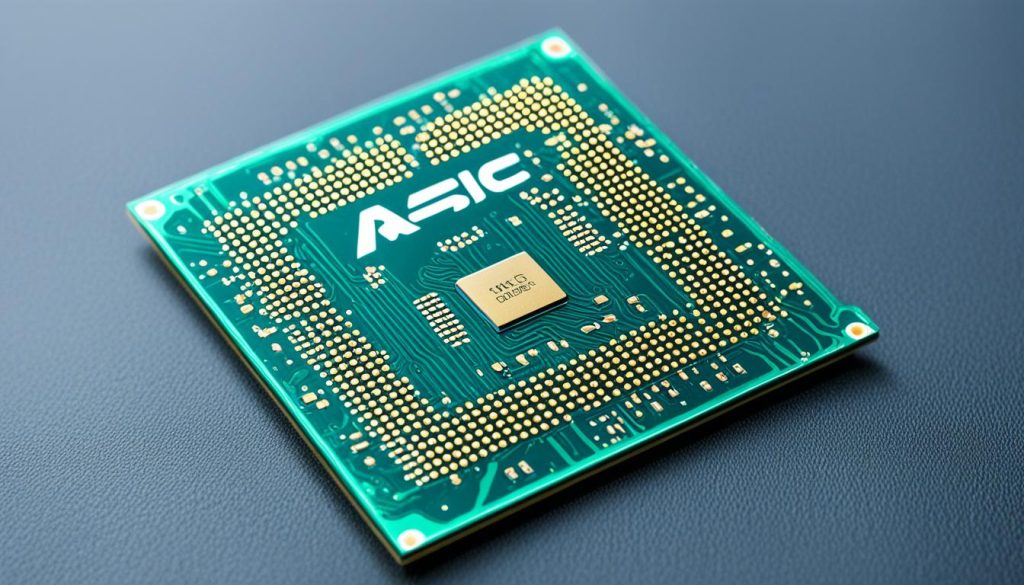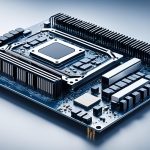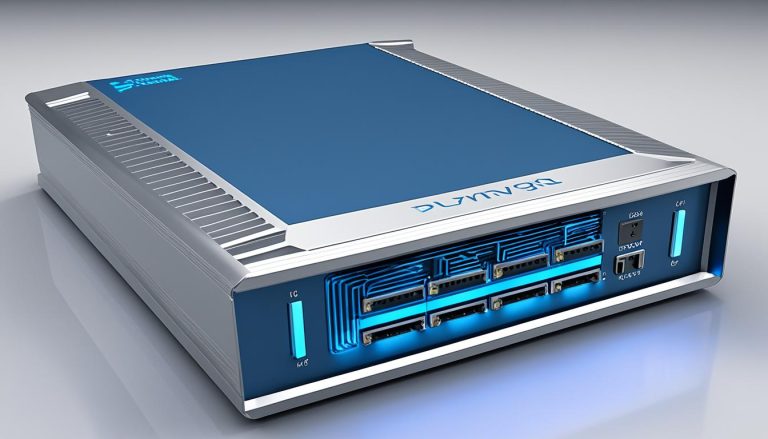In the rapidly advancing field of artificial intelligence (AI), machine learning (ML), and data science, the role of ASICs (Application-Specific Integrated Circuits) in dedicated neural network processing is becoming increasingly significant. ASICs, customized integrated circuits designed for specific applications, are driving computational efficiency and breakthroughs in AI, enabling real-world applications that were once unattainable.
ASICs offer a compelling solution for accelerating computations and optimizing performance in neural network processing. With their tailored design, ASICs outperform general-purpose processors by efficiently executing a specific set of functions required for neural network computations. This specialization results in superior performance, improved power efficiency, and cost-effectiveness.
Whether it’s deep learning, natural language processing, computer vision, or data analytics, ASICs are enhancing the performance and efficiency of AI/ML and data science applications. These specialized hardware accelerators play a crucial role in meeting the computational requirements of these domains, enabling groundbreaking advancements and real-world implementations.
Key Takeaways:
- ASICs are customized integrated circuits designed for specific applications, delivering superior performance and cost-effectiveness
- The specialization of ASICs in neural network processing improves computational efficiency, enabling breakthroughs in AI
- ASICs find applications in diverse fields such as deep learning, natural language processing, computer vision, and data analytics
- ASIC design has a rich history starting from military and aerospace applications, evolving with semiconductor technology advancements
- Career opportunities in ASIC design offer exciting prospects in hardware design, digital circuit design, and optimization in the field of AI/ML and data science
What is ASIC Design?
ASIC design, an acronym for Application-Specific Integrated Circuit design, involves the creation and production of integrated circuits that are customized for specific applications. Unlike general-purpose processors, ASICs are meticulously tailored to perform a specific set of functions with exceptional efficiency, resulting in optimized performance, power efficiency, and cost-effectiveness.
ASICs are designed to address the unique requirements of diverse industries, such as telecommunications, automotive, consumer electronics, and data centers. By incorporating specific functionalities and features directly into the integrated circuit, ASIC design enables the development of highly specialized hardware solutions that outperform general-purpose alternatives in terms of performance and cost.
With ASIC design, engineers have the flexibility to optimize various aspects of the integrated circuit, including logic design, architecture, and physical layout, catering to the specific demands of the target application. By leveraging this customization, ASIC designers can fine-tune the performance, power consumption, and size of the integrated circuit, creating a solution that precisely meets the needs of the intended use.
“ASIC design allows for the creation of tailored integrated circuits that deliver exceptional performance and efficiency while being optimized for specific applications.”
ASIC designs harness the power of integration, consolidating multiple functions into a single chip, resulting in reduced latency, improved reliability, and enhanced system performance. This miniaturization and consolidation of functionalities not only enable higher throughput but also contributes to overall system cost reduction by eliminating the need for additional components and reducing power consumption.
The versatility of ASIC design ensures its effectiveness across a wide range of industries and applications, including wireless communication, medical devices, automotive systems, and high-performance computing. In each of these domains, ASICs provide tailored solutions that deliver superior performance, power efficiency, and cost-effectiveness.
Benefits of ASIC Design:
- Optimized performance for specific applications
- Power efficiency and reduced energy consumption
- Cost-effectiveness through integration and miniaturization
- Enhanced system reliability and stability
- Customization to meet unique requirements
ASIC design is a fundamental pillar of modern semiconductor technology, empowering industries to create cutting-edge solutions that push the boundaries of innovation and solve complex challenges. By tailoring integrated circuits to specific applications, ASIC design unlocks new possibilities and fuels advancements in a wide range of fields.
ASIC Design in AI/ML and Data Science Applications
As AI/ML and data science continue to advance, the computational requirements for processing large amounts of data have become increasingly demanding. To meet these challenges, specialized ASICs have been developed to optimize the performance and efficiency of AI/ML algorithms.
ASIC design plays a crucial role in enabling efficient and fast processing of complex calculations involved in AI/ML and data science applications. These specialized ASICs are designed to accelerate key operations such as matrix multiplication, convolution, and neural network computations.
By implementing dedicated hardware accelerators through ASIC design, computational requirements can be met more efficiently and effectively. The hardware-level optimization and customization provided by specialized ASICs ensure superior performance compared to general-purpose processors.
Furthermore, ASIC design allows for the optimization of power efficiency, enabling AI/ML and data science applications to operate more efficiently with reduced power consumption.
“ASIC design in AI/ML and data science applications is like having a tailor-made tool for specific computations. It’s all about maximizing efficiency and performance through customized hardware acceleration.” – Expert in computational design.
The benefits of ASIC design in AI/ML and data science applications are far-reaching. These specialized ASICs enable breakthroughs in various fields by significantly reducing processing time, increasing throughput, and facilitating real-time data analysis.
Real-World Examples of ASIC Design in AI/ML and Data Science
Here are a few real-world examples that highlight the impact of ASIC design in AI/ML and data science applications:
- **Deep learning acceleration**: ASICs designed specifically for deep learning tasks, such as training and inference, can significantly speed up the processing of large neural networks.
- **Natural language processing**: ASICs optimized for natural language processing tasks can enhance language understanding, sentiment analysis, and machine translation.
- **Computer vision**: ASICs tailored for computer vision applications enable faster and more accurate image recognition, object detection, and video processing.
- **Data analytics and processing**: ASICs designed for data analytics and processing applications enable faster data processing, complex queries, and real-time insights for data-driven decision-making.
These examples demonstrate the critical role ASIC design plays in unlocking the full potential of AI/ML and data science applications, enabling groundbreaking advancements and empowering industries across various sectors.
A Glimpse into the Future
As AI/ML and data science continue to evolve, the demand for specialized ASICs will only grow. The need for computational efficiency and optimized performance will drive further innovations in ASIC design.
Specialized ASICs will continue to push the boundaries of what is possible in AI/ML and data science applications, allowing for faster processing, more complex computations, and greater insights from vast amounts of data.
With ongoing advancements in ASIC design and the development of specialized hardware accelerators, AI/ML and data science are poised to reach new heights, revolutionizing industries and transforming the way we live, work, and interact with technology.

Key Applications and Use Cases of ASICs
ASICs have revolutionized various domains in AI/ML and data science, enabling breakthroughs in computational efficiency and performance. These dedicated hardware accelerators find applications in several key areas, enhancing deep learning acceleration, natural language processing, computer vision, data analytics, and data processing.
One of the key applications of ASICs is deep learning acceleration, where they significantly speed up neural network computations. With their specialized architecture, ASICs can handle large-scale matrix multiplications and convolution operations required in deep learning models. This enables faster training and inference, making ASICs essential for real-time applications such as image recognition, speech processing, and autonomous vehicles.
Natural language processing (NLP) is another domain where ASICs play a vital role. ASICs designed specifically for NLP tasks, such as language modeling, machine translation, and sentiment analysis, can process vast amounts of textual data efficiently. By offloading complex computations to dedicated hardware, ASICs enable faster and more accurate NLP applications, facilitating advancements in language understanding and generation.
Computer vision is yet another area that benefits from ASICs. These specialized hardware accelerators enable enhanced image and video processing capabilities, making real-time object detection, recognition, and tracking possible. With ASICs, computer vision applications can operate at high speeds while maintaining accuracy, opening doors to a wide range of applications, including surveillance systems, autonomous drones, and augmented reality.
ASICs also find extensive use in data analytics and processing. They improve the performance and efficiency of data-intensive tasks such as database queries, data mining, and data filtering. By utilizing ASICs for these operations, organizations can extract insights from large datasets at a faster rate, leading to more informed decision-making and improved business outcomes.
To help illustrate the impact of ASICs in these key applications and use cases, take a look at the comparison table below:
| Application/Use Case | Benefits of ASICs |
|---|---|
| Deep Learning Acceleration | Significantly faster neural network computations Real-time image recognition and speech processing Improved performance in autonomous vehicles |
| Natural Language Processing | Faster language modeling and machine translation Improved sentiment analysis and language understanding |
| Computer Vision | Real-time object detection, recognition, and tracking Enhanced image and video processing capabilities |
| Data Analytics and Processing | Faster database queries and data mining Efficient data filtering and analysis |
As you can see, ASICs play a critical role in optimizing performance and efficiency across a wide range of applications in AI/ML and data science. They enable faster computations, real-time processing, and enhanced accuracy, positioning ASICs as key enablers of technological advancements in various industries.

History and Background of ASIC Design
The history of ASIC design can be traced back to the 1960s and 1970s when the first Application-Specific Integrated Circuits (ASICs) were developed for military and aerospace applications. These early ASICs were designed to meet the unique requirements and challenges of these industries, where reliability, performance, and power efficiency were crucial.
As advancements in semiconductor manufacturing technology rapidly progressed, so did the complexity and capabilities of ASICs. These advancements allowed for the integration of more transistors on a single chip, resulting in enhanced functionality and performance. The miniaturization of electronic components, along with improvements in speed and power consumption, further propelled the evolution of ASIC design.
ASICs quickly became indispensable in military and aerospace applications due to their ability to deliver high performance while operating under extreme conditions. Their robustness and reliability made them ideal for critical tasks such as signal processing, control systems, and data acquisition.
Over time, ASIC design expanded beyond military and aerospace applications into a wide range of industries. The versatility and customization offered by ASICs opened up new possibilities for various sectors, including telecommunications, automotive, consumer electronics, and medical devices.
The semiconductor manufacturing technology advancements that fueled the growth of ASIC design also played a vital role in enabling other cutting-edge technologies. The continued advancements in semiconductor manufacturing processes, such as lithography and wafer fabrication, allowed for the production of smaller, faster, and more power-efficient ASICs.
“ASIC design has been instrumental in the development of advanced electronic systems for military, aerospace, and a multitude of other industries. Its history is closely intertwined with the evolution of semiconductor manufacturing technology, which continues to push the boundaries of what ASICs can achieve.”
Today, ASIC design remains at the forefront of innovation, driving progress in fields such as artificial intelligence, machine learning, data centers, and Internet of Things (IoT) devices. The relentless pursuit of higher computational performance, power efficiency, and cost-effectiveness has positioned ASICs as a fundamental building block in the modern era of electronics.
As ASIC design continues to evolve and adapt to emerging technologies, its history and background serve as a reminder of the remarkable advancements that have shaped the world of integrated circuits.
ASIC Design Process and Methodologies
In order to create ASICs that meet the required performance goals and specifications, the ASIC design process involves several stages. These stages include system design, architecture definition, logic design, verification, physical design, and manufacturing.
1. System Design
The first stage of the ASIC design process is system design. During this phase, the design team determines the requirements and functionality of the ASIC based on the target application. The team identifies the key features and specifications that the ASIC needs to deliver, taking into consideration factors such as power consumption, speed, and size.
2. Architecture Definition
Once the system design is complete, the architecture definition stage begins. This stage involves defining the high-level structure and organization of the ASIC. The design team determines the overall system architecture, including the major components and their interconnections. The team also considers the resources needed for the ASIC, such as memory, processing units, and I/O interfaces.
3. Logic Design
In the logic design stage, the design team focuses on creating the digital logic circuits that implement the desired functionality of the ASIC. The team uses hardware description languages (HDL) to define the behavior and structure of the logic circuits. They also perform logic optimization to minimize power consumption and maximize performance.
4. Verification
Verification is a critical stage in the ASIC design process. During this phase, the design team ensures that the ASIC functions as intended and meets the specified requirements. Various verification techniques, such as simulation and formal verification, are employed to validate the ASIC’s functionality and performance. This stage helps identify and rectify any design issues and bugs before proceeding with manufacturing.
5. Physical Design
The physical design stage involves translating the logic design into physical layout. The design team determines the placement and routing of the ASIC’s components, optimizing for timing, power, and manufacturability. They use electronic design automation (EDA) tools to generate the detailed layout of the ASIC, considering factors such as signal integrity, power distribution, and thermal characteristics.
6. Manufacturing
The final stage of the ASIC design process is manufacturing. Once the physical design is complete, the ASIC is fabricated using semiconductor manufacturing processes. This involves the creation of masks, wafer fabrication, and packaging. Quality assurance tests are conducted to ensure that the manufactured ASICs meet the design specifications and are free from defects.
By following this comprehensive ASIC design process, designers can produce high-quality ASICs that are optimized for their intended applications, providing superior performance, power efficiency, and cost-effectiveness.
| Stage | Description |
|---|---|
| System Design | Determining requirements and functionality of the ASIC |
| Architecture Definition | Defining high-level structure and organization of the ASIC |
| Logic Design | Creating digital logic circuits implementing ASIC functionality |
| Verification | Validating ASIC functionality and performance |
| Physical Design | Translating logic design into physical layout |
| Manufacturing | Fabricating the ASIC using semiconductor manufacturing processes |
Career Aspects and Industry Relevance of ASIC Design in AI/ML and Data Science
ASIC design is a field that presents promising career opportunities for professionals interested in hardware design, digital circuit design, and optimization. In the context of AI/ML and data science, ASICs play a vital role in enabling breakthroughs and driving innovation in these domains.
Professionals skilled in ASIC design possess the expertise to design and develop customized integrated circuits that are specifically tailored for AI/ML and data science applications. By optimizing the performance and efficiency of ASICs, these professionals contribute to the advancement of computational capabilities in the field.
An understanding of hardware design principles, digital circuit design, and optimization techniques is crucial for professionals in the ASIC design industry. This knowledge allows them to create specialized ASICs that address the unique computational requirements of AI/ML algorithms and data science applications.
The industry relevance of ASIC design in AI/ML and data science is evident in key areas such as deep learning acceleration, natural language processing, computer vision, data analytics, and data processing. These applications heavily rely on specialized ASICs to enhance performance, efficiency, and speed in their respective processes.
Furthermore, the continuous advancements in AI/ML and data science call for professionals who possess the skills to design and develop ASICs that can keep up with the evolving technological landscape. As AI/ML algorithms become more complex and data-intensive, the demand for ASIC designers with expertise in optimization and high-performance computing is expected to grow.
Industry Relevance
“ASIC design professionals play a crucial role in the AI/ML and data science industries by creating specialized hardware solutions that optimize computational efficiency and enable groundbreaking advancements in these fields.”
Exploring a career in ASIC design offers exciting opportunities to work on cutting-edge technologies and contribute to the development of the next generation of AI/ML and data science solutions. With the increasing demand for specialized hardware accelerators in these domains, ASIC design professionals will continue to play an integral role in shaping the future of AI/ML and data science.
| Key Skills and Expertise | Industry Applications |
|---|---|
| Hardware Design | Deep Learning Acceleration |
| Digital Circuit Design | Natural Language Processing |
| Optimization Techniques | Computer Vision |
| Analog/Digital Signal Processing | Data Analytics |
| ASIC Verification | Data Processing |
Conclusion
ASIC design is a critical component in driving computational efficiency and enabling breakthroughs in the fields of AI/ML and data science. By customizing ASICs for specific applications, designers can achieve superior performance, power efficiency, and cost-effectiveness. As the demand for specialized hardware accelerators continues to grow, ASIC design presents exciting opportunities for professionals in this field.
The advancements in ASIC design have revolutionized the AI/ML and data science industries. By integrating specialized hardware accelerators into AI systems, the computational efficiency of tasks such as deep learning, natural language processing, and computer vision can be significantly improved. This increased efficiency allows for faster data processing, more accurate predictions, and the development of complex algorithms.
Looking ahead, ASIC design will continue to shape the future of AI/ML and data science. The ability to create specialized hardware accelerators tailored to the specific needs of these fields opens up new possibilities for innovation and advancement. As technologies evolve and computational requirements increase, ASIC design will play an even more crucial role in driving the next generation of AI/ML and data science breakthroughs.
FAQ
What is the role of ASICs in dedicated neural network processing?
ASICs play a crucial role in accelerating computations and improving performance in the field of AI. They are customized integrated circuits tailored for specific applications, delivering superior performance, power efficiency, and cost-effectiveness compared to alternative solutions.
What is ASIC design?
ASIC design refers to the process of designing and manufacturing integrated circuits that are customized for specific applications. Unlike general-purpose processors, ASICs are tailored to perform a specific set of functions efficiently, resulting in optimized performance, power efficiency, and cost-effectiveness.
How does ASIC design relate to AI/ML and data science applications?
The demanding computational requirements of AI/ML and data science have led to the development of specialized ASICs. These ASICs are designed to accelerate key operations involved in AI/ML algorithms, such as matrix multiplication, convolution, and neural network computations, leading to improved performance and efficiency.
What are some key applications and use cases of ASICs in AI/ML and data science?
ASICs find numerous applications in AI/ML and data science domains such as deep learning acceleration, natural language processing, computer vision, and data analytics and processing. These specialized ASICs enhance the performance and efficiency of various tasks and operations within these domains.
What is the history and background of ASIC design?
The concept of ASICs dates back to the 1960s and 1970s when the first ASICs were developed for military and aerospace applications. Over the years, with advancements in semiconductor manufacturing technology, the complexity and capabilities of ASICs have grown exponentially.
What does the ASIC design process involve?
The ASIC design process involves several stages, including system design, architecture definition, logic design, verification, physical design, and manufacturing. Each stage is crucial for the successful design and production of ASICs, considering the target application, performance goals, and adherence to design specifications.
What career opportunities are available in ASIC design for AI/ML and data science?
ASIC design in the field of AI/ML and data science offers exciting career opportunities for professionals with expertise in hardware design, digital circuit design, and optimization. Professionals in this field play a crucial role in designing and developing ASICs that enable breakthroughs in AI/ML and data science, driving innovation and advancing the industry.
What is the importance of ASIC design in AI/ML and data science?
ASIC design plays a pivotal role in enhancing computational efficiency for breakthroughs in AI/ML and data science. The customization of ASICs for specific applications allows for superior performance, power efficiency, and cost-effectiveness. As the demand for specialized hardware accelerators grows, ASIC design presents exciting opportunities and continues to shape the future of AI/ML and data science.



















